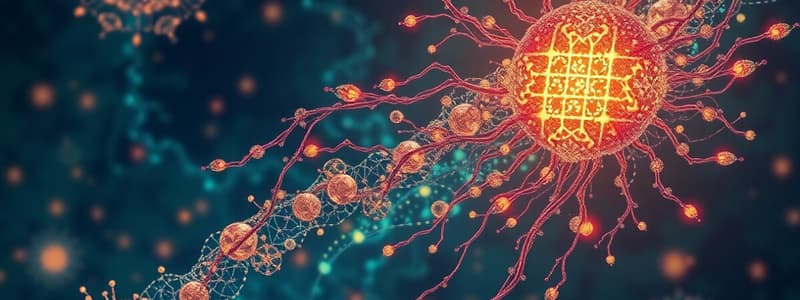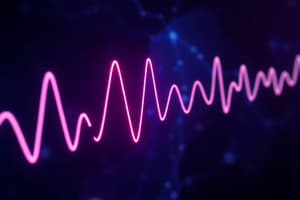Podcast
Questions and Answers
What is the direct effect of an inward current on the membrane potential of a cell?
What is the direct effect of an inward current on the membrane potential of a cell?
- Depolarization (correct)
- Hyperpolarization
- Stabilization
- No change in potential
The refractory period ensures that action potentials can propagate bidirectionally along the axon without any limitations.
The refractory period ensures that action potentials can propagate bidirectionally along the axon without any limitations.
False (B)
Explain the role of voltage-gated sodium channels in the initiation of an action potential.
Explain the role of voltage-gated sodium channels in the initiation of an action potential.
Voltage-gated sodium channels open in response to depolarization, allowing Na+ ions to rush into the cell, further depolarizing the membrane and initiating the action potential.
The membrane potential at which the occurrence of an action potential is inevitable is called the ______ potential.
The membrane potential at which the occurrence of an action potential is inevitable is called the ______ potential.
Match the following terms with their descriptions:
Match the following terms with their descriptions:
Which characteristic is NOT typical of action potentials?
Which characteristic is NOT typical of action potentials?
Action potentials are the primary mechanism for information transmission only in muscle cells; nerve cells use alternative methods.
Action potentials are the primary mechanism for information transmission only in muscle cells; nerve cells use alternative methods.
Describe how the concentration of Na+ inside the cell influences the action potential.
Describe how the concentration of Na+ inside the cell influences the action potential.
Which factor directly determines the magnitude (mV) of a diffusion potential?
Which factor directly determines the magnitude (mV) of a diffusion potential?
Equilibrium potential is achieved when the chemical and electrical driving forces acting on an ion are balanced, preventing net diffusion.
Equilibrium potential is achieved when the chemical and electrical driving forces acting on an ion are balanced, preventing net diffusion.
Define resting membrane potential and explain in which type of cells it is typically found.
Define resting membrane potential and explain in which type of cells it is typically found.
The resting membrane potential is primarily established by ___________ potentials resulting from concentration differences for ions across the cell membrane.
The resting membrane potential is primarily established by ___________ potentials resulting from concentration differences for ions across the cell membrane.
Which ions' permeabilities most influence the resting membrane potential in excitable cells?
Which ions' permeabilities most influence the resting membrane potential in excitable cells?
Match each factor with its effect on the resting membrane potential:
Match each factor with its effect on the resting membrane potential:
What is the typical range of the resting membrane potential in most excitable cells?
What is the typical range of the resting membrane potential in most excitable cells?
How does the Na+/K+ ATPase contribute to the generation of resting membrane potential?
How does the Na+/K+ ATPase contribute to the generation of resting membrane potential?
In a converging neural circuit, what is the primary characteristic of the postsynaptic neuron's inputs?
In a converging neural circuit, what is the primary characteristic of the postsynaptic neuron's inputs?
In a reverberating circuit, once the circuit is initiated, it continues to propagate signals indefinitely without any need for further external stimuli.
In a reverberating circuit, once the circuit is initiated, it continues to propagate signals indefinitely without any need for further external stimuli.
Describe the key feature that distinguishes a parallel after-discharge circuit from other types of neural circuits.
Describe the key feature that distinguishes a parallel after-discharge circuit from other types of neural circuits.
In a reverberating circuit, branches from ______ neurons synapse with earlier ones, sending action potentials back through the circuit repeatedly.
In a reverberating circuit, branches from ______ neurons synapse with earlier ones, sending action potentials back through the circuit repeatedly.
Match each neural circuit type with its description:
Match each neural circuit type with its description:
What is the primary function of a synapse?
What is the primary function of a synapse?
An Inhibitory Post-Synaptic Potential (IPSP) results in a depolarization of the post-synaptic membrane.
An Inhibitory Post-Synaptic Potential (IPSP) results in a depolarization of the post-synaptic membrane.
What determines whether an action potential will occur in the post-synaptic neuron, based on IPSPs and EPSPs?
What determines whether an action potential will occur in the post-synaptic neuron, based on IPSPs and EPSPs?
Neurotransmitters must be degraded or removed to ______ the signal transduction.
Neurotransmitters must be degraded or removed to ______ the signal transduction.
Which type of receptor functions directly as a ligand-gated ion channel?
Which type of receptor functions directly as a ligand-gated ion channel?
What is the role of presynaptic modulation in neurotransmitter release?
What is the role of presynaptic modulation in neurotransmitter release?
Match the potential with its definition.
Match the potential with its definition.
In a diverging neural circuit, what happens to a signal from one presynaptic neuron?
In a diverging neural circuit, what happens to a signal from one presynaptic neuron?
Study Notes
- Human Physiology BIOL 2052
- Instructor: Dr. Cristina V Dieni
- Email: [email protected]
- Phone: 942-4291, ext. 2248
- Office: BGSC213
Diffusion Potential
- Generated across a membrane when an ion diffuses down its concentration gradient
- Measured in millivolts (mV) and depends on the size of the concentration gradient or driving force
- The sign depends on the charge of the diffusing ion.
Equilibrium Potential
- The diffusion potential that exactly balances or opposes the tendency for diffusion down the concentration difference
- At electrochemical equilibrium, the chemical and electrical driving forces acting on an ion are equal and opposite, and no further net diffusion occurs
Resting Membrane Potential
- The potential difference that exists across the membrane of excitable cells such as nerve and muscle in the period between action potentials (i.e., at rest)
- Established by diffusion potentials, which result from the concentration differences for various ions across the cell membrane
- Each permeant ion attempts to drive the membrane potential toward its own equilibrium potential
- Ions with the highest permeabilities or conductances at rest will make the greatest contributions to the resting membrane potential; those with the lowest permeabilities will make little or no contribution
Determinants of Resting Membrane Potential:
- Unequal distribution of ions in the ECF and cytosol
- Differences in membrane permeability
- Action of the Na+/K+ ATPase also contributes to the generation of the resting membrane potential
- The resting membrane potential of most excitable cells falls in the range of -70 to -80 mV -These values are relative to the permeability of the cell membrane
- The resting membrane potential is close to the equilibrium potentials for K+ and Cl- because the permeability to these ions at rest is high
Action Potentials
- A phenomenon of excitable cells such as nerve and muscle
- A rapid depolarization (upstroke) followed by repolarization of the membrane potential
- The basic mechanism for transmission of information in the nervous system and in all types of muscle
Characteristics of Action Potentials
- Stereotypical size and shape: Each normal action potential for a given cell type looks identical, depolarizes to the same potential, and repolarizes back to the same resting potential
- Propagation: An action potential at one site causes depolarization at adjacent sites, bringing those adjacent sites to threshold. Propagation of action potentials from one site to the next is nondecremental
Action potential initiation
- Action potentials are initiated by depolarization-induced inward flow of Na+
Key Terms
- Depolarization: The process of making the membrane potential less negative
- Hyperpolarization: The process of making the membrane potential more negative
- Inward Current: The flow of positive charge into the cell, depolarizing the membrane potential
- Outward Current: The flow of positive charge out of the cell, hyperpolarizing the membrane potential
- Threshold Potential: The membrane potential at which the occurrence of an action potential is inevitable, is less negative than the resting membrane potential, and an inward current is required to depolarize the membrane potential to the threshold
- Refractory Period: A period during which another normal action potential cannot be elicited in an excitable cell. Refractory periods can be absolute or relative
Voltage-Gated Ion Channels
- Subunits change conformation with changes of membrane potential
- Two types of voltage-gated channels play a role in producing action potentials: voltage-gated sodium channels & voltage-gated potassium channels.
- Concentrated in the initial segment of the axon (axon hillock)
- If the inside of the axon hillock depolarizes (less negatively charged), the Na+ channels open and allow Na+ to enter the neuron
- Na+ concentration is low inside the cell (due to the actions of
Synapse
- The point at which one neuron communicates with another neuron or a target tissue
Signal Transmission at a Chemical Synapse
- Action potential arrives at the synaptic end bulb
- Voltage-gated Ca2+ channesl open, Ca2+ enters
- Synaptic vesicles fuse with memberane
- Neurotransmitter is released into synaptic cleft
- Neurotransmitter binds to receptor on post-synpatic neuron
- Ion channels open
- Leading to post synaptic potential
- If threshold is reached, then an action potential occurs on the postsynaptic neuron
- Ca2+, SNAREs, and synaptotagmin play a role in neurotransmitter release
IPSP vs EPSP
- Inhibitory Post-Synaptic Potential (IPSP): Neurotransmitter release results in a hyperpolarization of the post-synaptic membrane
- Excitatory Post-Synaptic Potential (EPSP): Neurotransmitter release results in a depolarization of the post-synaptic membrane
Summation of IPSP and EPSP
- If the net summation of EPSPs and IPSPs is a depolarization that reaches threshold, then an action potential occurs at the trigger zone of the postsynaptic neuron
Receptor Types:
- Ionotropic receptors function as ligand-gated channels
- Metabotropic receptors function through a G-protein
Termination of Signal:
- Neurotransmitters must be degraded or removed in order to terminate the signal transduction
Regulation of Neurotransmitter Release:
- Presynaptic modulation can regulate neurotransmitter release, leading to either increased or decreased release
Small Molecule Neurotransmitters
- Acetylcholine
- Amino Acids: Glutamate, Aspartate, Gamma aminobutyric acid (GABA), and Glycine
- Biogenic Amines: Dopamine, Norepinephrine, Epinephrine, Serotonin
- Gasses: Nitric Oxide and Carbon Monoxide
- Neurpeptides: Endocannabinoids, Enkephalin and Substance P
Neural Circuits Types:
- Diverging circuit: a single presynaptic neuron synapses with several postsynaptic neurons
- Converging circuit: the postsynaptic neuron receives action potentials from several different sources
- Reverberating circuit: an incoming action potential stimulates the first neuron, which stimulates the second, which stimulates the third, and so on. Branches from later neurons synapse with earlier ones, sending action potentials back through the circuit again and again
- Parallel after-discharge circuit: a single presynaptic cell stimulates a group of neurons, each of which synapses with a common postsynaptic cell
Studying That Suits You
Use AI to generate personalized quizzes and flashcards to suit your learning preferences.



